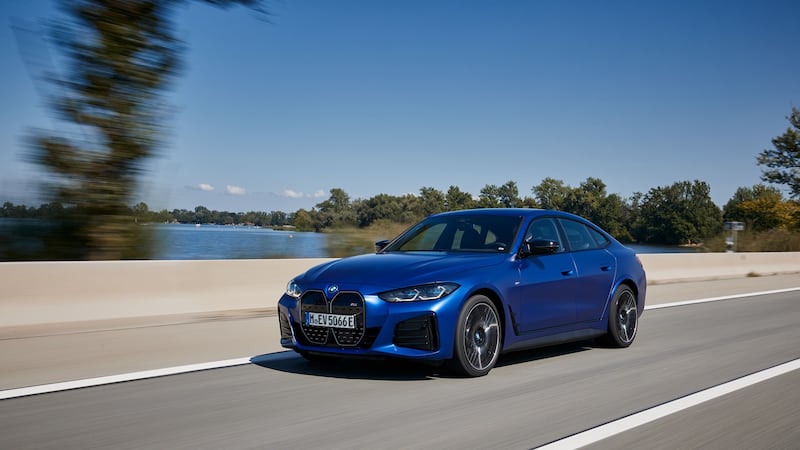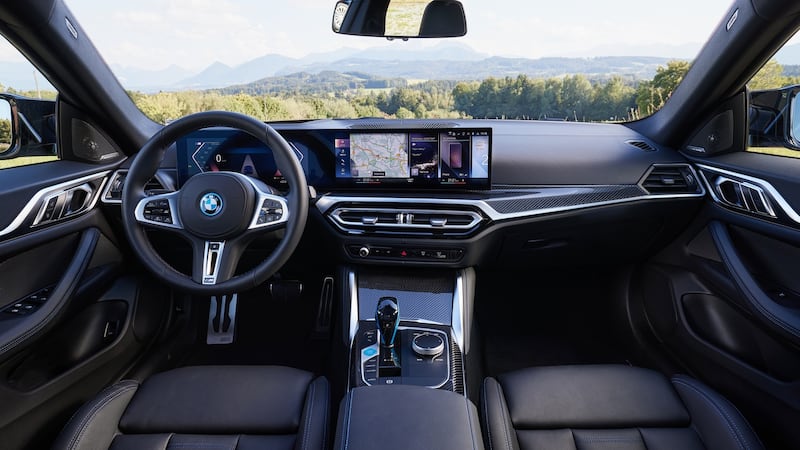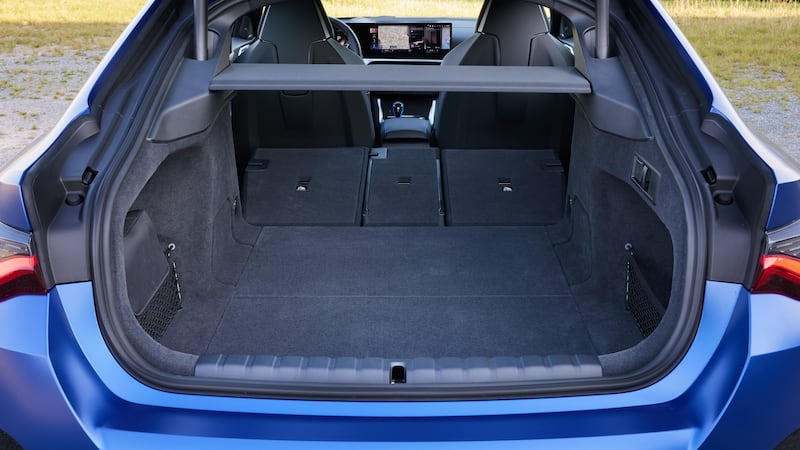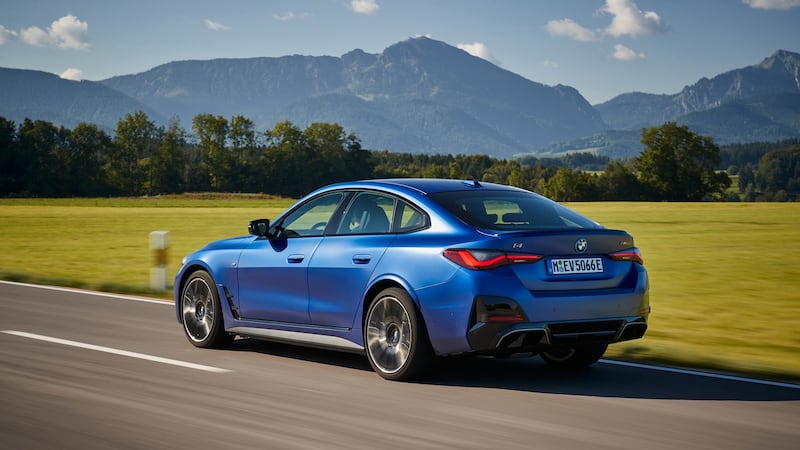This may look like a regular BMW but it's probably the car buyers have been waiting for more than a decade to see on the road. BMW were early to the electric party with the i3 city car and recently addressed the crossover craze. But for many fans, the brand's heart is still with saloon cars, so the first all-electric coupe saloon is a landmark moment.
This conventional looking car makes a compelling argument to transition to the greener energy source that even the most conservative of buyers cannot ignore.
The i4 isn't just a reworked 4 Series Gran Coupe with its engine swapped out for a Duracell bunny, it's much more. We went to Bavaria to test the i4 in M50 M-Sport guise and whatever cobwebs we arrived with were well and truly blown away thanks in no small part to its 544hp.
While buyers still flock to SUVs and crossovers, the i4’s saloon format blends in with every other car on the road, and some people like that. In fact, you could easily lose track of your i4 in any car park.

Like the 4 Series GC, the i4 is perfect for those who still need to transport the kids but don't feel old enough to desire a 5 Series or iX. It is a handsome car, but no Audi e-tron GT (€103,890) in terms of exterior styling. The i4 scores better inside with its well put together cabin.
BMW has been able to cleverly achieve a low, 4 Series-like driving position that even electric vehicle (EV) drivers will find refreshingly sporty. General cabin space is similar to the 4 Series. I was able to get in the back, behind the driving seat, with only modest effort. Our i4 has a lower centre of gravity than a 3 Series and almost perfectly balanced weight distribution.
Like the BMW iX the i4 gets a huge widescreen digital display powered by BMW's new OS8 operating system. Apart from looking at the navigation in widescreen and occasionally Apple CarPlay in a novel ultra-wide layout – the screen is capable of so much more, but I didn't use much of it. Future subscription services are on the way, and these will add to all the menus and sub menus already on the display – maybe that's why they installed the huge display in in the first place.
Our i4 is not a pure M car but an M-Performance car. Since 1972 BMW M division cars have attained legendary status among enthusiasts. Intoxicating, emissions-belching fossil fuel engines have been the key powering glorious M cars like the M1, M3 and M5. The dogs in the street know the days of the internal combustion engine, in the first world at least, are numbered, but thankfully electric motors can provide thrills too.

In truth EVs are already outperforming sporty engines and our M50, with a 0-100km/h time of 3.9 seconds, is a case in point. Even the entry model i4, eDrive 40, produces 340hp and features a maximum range from a single charge of 590km – you wouldn’t get that range to a tank of petrol blasting around in an M5.
BMW says the new i4 should be seen as its new “ultimate driving machine” and with a base model with more than 300hp and a range-topping M60 on the way, who could argue against it? The i4’s underfloor houses a bank of low-profile BMW designed rechargeable batteries that power the xDrive’s dual electric motors. The i4 uses the same generation 5 battery and motor technology that showcased in the BMW iX.
While the traditional car shape is losing out to SUVs and crossovers in the new car market, a saloon still makes a lot of sense in terms of energy efficiency. The i4’s very low centre of gravity and aerodynamic drag qualities benefit reduced energy consumption, especially at high speed. The open road offers very little opportunity for electrical recuperation from braking and remains the prime enemy of the electric car. The i4 seems to have cracked that nut.
Our test car performance is comparable to the latest M4 dynamically, but not on price. Because of Ireland’s emissions-based taxation, an M4 costs €128,075 while the i4 M50 costs €78,315. Annual motor tax for an M4 is €1,200 – its €120 for an i4.

The M50, unlike the motorway, is incredibly fast thanks to 544hp and its whopping 795nm of torque. BMW’s latest electronics allow the car’s xDrive all-wheel drive system to react to either axle’s traction needs astonishingly quickly. Like the iX, its motors don’t use any rare earth metals and are highly efficient. The i4 has an 11kW onboard charger capability and can access high-powered DC charging (with speeds up to 200kW max) via its CCS socket. In 10 minutes at a high-powered charger the entry i4 eDrive40 can gain up to 165km range (140km / M50).
To say the i4 M50 is responsive on the road is an understatement. It has neck-snapping acceleration. No matter what speed you are travelling, if you kick down on the accelerator you will get instant thrust with no need to build up the revs as you would with an M4. If you select sport from one of the car’s three drive modes (eco/comfort/sport) you can get the benefit of an artificial noise generator that adds audible theatre to the act of accelerating.
Composer Hans Zimmer is the musical genius behind the i4's sound design. The sounds generated are a far cry from The Lion King soundtrack, but there are hints of the Blade Runner sequel. The electric motor note played through the speakers in sport mode is grin inducing and quite distinct.
Rather than mimicking a V8 or another petrol engine revving up, its sound is more a sci-fi twist of the process, with the right amount of Star Wars thrown in. The car even makes a down-shift noise when you pop the auto gear lever from D to B (brake regeneration). In comfort mode the dramatic SFX noise is reduced but still present, and at times I felt as if I was in a conventional 4 Series and not the cutting edge of electric vehicle design. In eco mode the driving experience is almost silent.
The i4 handles brilliantly. Swift cornering is effortless and mere mortals with average talent will feel like driving gods. One familiar mountain road climb was dispatched in a fraction of the time it took me, not long ago, in a conventional performance car. The i4’s traction and endless amounts of pulling power could manage a vertical take-off if so desired. Overall, the i4 driving experience is sure footed and only becomes “interesting” above 200km/h on the autobahn, where the car can feel a little light. My comfort zone limit was reached at the car’s top speed of 225km/h. (An optional rear boot spoiler that aids high speed stability is available.)

The i4 range starts with the rear-wheel drive eDrive40 (€63,565). It produces 340hp/430nm, top speed is 189km/h, and can sprint from 0-100km in 5.7 seconds. Two grades feature sport and M-sport (€65,405). Our test i4 xDrive M50 model tops the range for now and consumes between 19-24kWh/100km. The ultra-modern i4 is being built in BMW’s oldest car plant in Munich. The plant’s internal combustion engine production line is winding down as it transitions to fully electrified production over the coming years.
In terms of direct electric powered rivals, the i4 has to contend with the slightly shorter Tesla Model 3 for now. Its pricing starts from €48,990 (standard range plus). The Model 3 Performance version at €65,990 with a 567km range, 261km/h top speed and a 3.3 0-100km/h time beats the i4 xDrive M50 in top trumps and has more cabin space too.
The i4 in xDrive M50 guise delivers zero emissions and traditional M-car-like dynamic performance at a fraction of its cost. It is fair to say the letter 'I' will join 'M' as one all car enthusiasts can get excited about. The i4 arrives in Ireland this December with deliveries to customers starting in March 2022.









